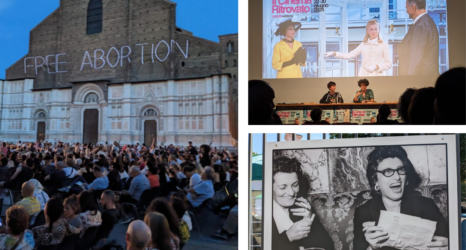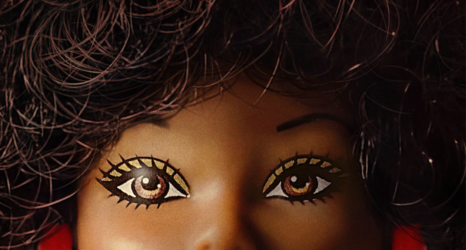The film adaptation of the Tony Award-winning Stephen Sondheim/James Lapine musical Into the Woods should please feminist lovers of musicals, fairy tales and narratives that don’t take themselves too seriously.
The film, like the play, pokes fun at our all-too-human wishes and failed quests and, oh joy of joys, suggests heteromonogamy is the true tall tale. The humor-inflected narrative–pervaded with a mocking, parodic tone–as well as various lovely, feminist-friendly reversals, results in a film adaptation ripe for feminist musing. However, as the holidays are in full force and most of us are likely caught up in some sort of bustle, I will focus only on perhaps its most ground-breaking reversal of the fairy-tale genre: namely, there is no “and they lived happily ever after” in a monogamous duo of prince/princess. And this is a Disney film, no less!
The meditation on traditional romance as something one should run from rather than towards begins early in the film, with Cinderella (Anna Kendrick) not charmed by Prince Charming–who, tellingly, is instead called “Cinderella’s Prince” (Chris Pine). Instead, she purposefully runs from him several times, eventually singing about her quandary in “On the Steps of the Palace,” in which she considers if she actually wants to be “caught”:
You think, make a decision.
Why not stay and be caught?
You think, well, it’s a thought …
Speaking volumes about the thrill of the chase, Cinderella notes the excitement of such customs, yet hints at the underlying fear romantic relationships engender–that one might get “caught” and not be able to leave:
To arrive at a ball
Is exciting and all-
Once you’re there, though, it’s scary.
And it’s fun to deceive
When you know you can leave
Later, this sense of being “caught” is one that she notes brings security, as she sings of being a prisoner in her own home with her stepmother and stepsisters:
You’ll be better off there
Where there’s nothing to choose,
So there’s nothing to lose.
Since she’s not ready to choose whether to pursue the prince, she sings:
You know what your decision is,
Which is not to decide.
Instead, she leaves him with a shoe, suggesting he will have to decide:
Now it’s he and not you
Who is stuck with a shoe,
In a stew, in the goo …
However, by leaving the shoe, she is making a decision–intentionally opening the door for him to find her via the golden slipper. In most versions of the tale, the shoe slips from her foot as she runs from the ball before the fairy godmother’s magic runs out. Into the Woods, notably, has no fairy godmother.
Earlier, in “Agony” the two male princes of the narrative sing about whose pain is worse, given that their respective princesses (Cinderella and Rapunzel) don’t seem to want them. This, too, is a reversal, since it is usually females who are depicted as pining away for love.
It is “agony” that they do not seem to be desired, thus they ask
Am I not sensitive,
Clever,
Well-mannered,
Considerate,
Passionate,
Charming,
As kind as I’m handsome
And heir to a throne?
In the film, the song is performed for particularly comic effect, with the princes jumping from rock to rock in the river, getting precariously closer to the cliff’s edge as they try to “out-agony” each other while showing off their “manliness.” One prince pops open the buttons of his shirt to reveal his chest, prompting the other to do the same. And just as one jumps daringly to prove his courage, the other follows with an even grander jump. This metaphorical chest-pumping is one of the funniest segments and allows us to glimpse something rarely seen in films: men acting as fools for love and being mocked for it, even scorned for their insistence that “I must have her to wife.”
Though the princes do ultimately marry their respective princesses, this brings no happily-ever-after. Instead, at the post-nuptial celebration at the castle, just after the narrator opines “all that seemed wrong was now right,” the revelers—happy couples included—are shaken by what the prince decides is an earthquake. Rather, the jolts are being caused by a giant—and a lady giant at that. Yet another fairy-tale reversal.
The arrival of the female giant prompts all the characters to venture into the woods again, where some of the most radical reversals occur–especially in relation to heteronormative romance.
In the play, the two lead princes, once back in the woods, reveal that they have grown bored in their marriages and now lust after Snow White and Sleeping Beauty. In the film, however, this is scrapped (strengthening, I would argue, the critique of hetero-coupledom). Thankfully, another key scene and song in this vein remains, however—the encounter between Cinderella’s Prince and the Baker’s Wife (Emily Blunt).
The Baker’s Wife has suffered throughout the play with her rather bumbling, forgetful, condescending husband. As her moniker portends, she is treated by him as “his wife” first and foremost, whom he can order around and claim to protect. While the narrative troubles this stance of his, showing he learns “It Takes Two,” her encounter with the Prince and the song that ensues (“Any Moment” ) is far more radical in terms of questioning the institution of heteromonogamous marriage. After the prince asks to kiss the Baker’s Wife (a nice nod to consent!), she responds
This is ridiculous,
What am I doing here?
I’m in the wrong story
Answering, “Don’t feel rushed” he goes on,
Days are made of moments,
All are worth exploring.
Many kinds of moments–
None is worth ignoring.
All we have are moments,
Memories for storing.
One would be so boring …
Thought she retorts “This is not right!” he argues
Right and wrong don’t matter in the woods,
Only feelings.
Let us meet the moment unblushed.
Life is often so unpleasant-
You must know that, as a peasant-
Best to take the moment present
As a present for the moment.
The actions and lyrics suggest the prince and the baker’s wife do indeed have “a moment,” while the nod to her unpleasant life as a peasant acknowledges the class restrictions of marriage as an institution. It is in the woods, the narrative keeps suggesting, away from societal dictates, that such moments can be had. While the Baker’s Wife hopes they will find each other for more “moments,” the prince relates
This was just a moment in the woods.
Our moment,
Shimmering and lovely and sad.
Leave the moment, just be glad
For the moment that we had.
Every moment is of moment
When you’re in the woods …
His “goodbye” could be read to suggest he is a cad, using her for a mere “moment,” but I choose to see it rather as an ode to love (and sexual excitement) as both expansive and fleeting—-as something one can not predict, control, let alone “own” (as suggested by traditional marriage and the “taking” of a spouse).
After his departure, the Baker’s Wife’s song “Moments in the Woods” continues the interrogation of traditional romance, asking “What is it about the woods?”
Back to life, back to sense,
Back to child, back to husband,
You can’t live in the woods.
There are vows, there are ties,
There are needs, there are standards,
There are shouldn’ts and shoulds.
She ultimately queries
Why not both instead?
There’s the answer, if you’re clever:
Have a child for warmth,
And a Baker for bread,
And a Prince for whatever-
Blunt’s delivery of these lines is particularly delicious, making it apparent the wife lusts for the pleasure and excitement her dalliance with the prince afforded. Alas, the voice in her head, that of societal dictates, instructs her to “Face the facts … Just get out of these woods.”
SPOILER ALERT!!!
Although she ultimately dies in the film (as in the play), which could be read as her punishment for infidelity, The Baker’s Wife’s death can also be argued as metaphorical release from the dictates of a too strict society—as in the classic novel The Awakening, or even as with Thelma and Louise’s iconic drive to the Grand Canyon, where they choose the open abyss rather than facing the phallic arm of the law.
Indeed, this song espouses the “both/and” mantra of intersectional feminism: the belief that dichotomies are limiting and hierarchies a bore. It champions instead the notion that it does not have to be either/or but can be and as well as or:
Must it all be either less or more,
Either plain or grand?
Is it always “or”?
Is it never “and”?
That’s what woods are for …
I encourage you to venture out to see Into the Woods, not only for its celebration of a life lived by the mantra “both/and,” but also for its stellar cast, its magical fairy-tale reversals and its notion that a life in the woods, filled with witches, giants and enchantment, can be far more enticing than just sticking by the stove baking.





